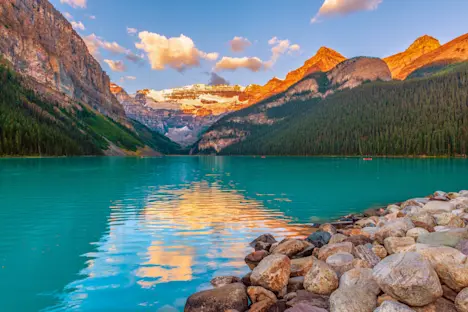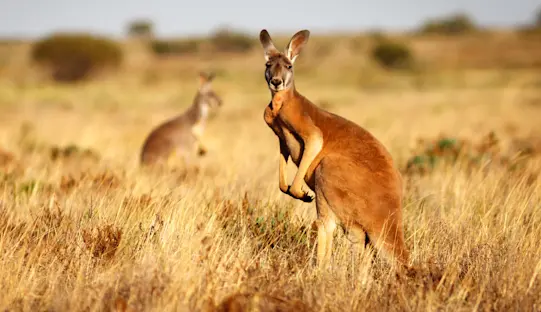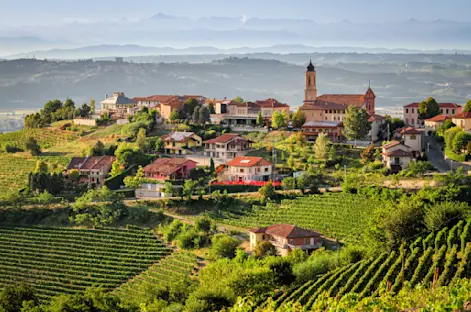On the first evening of my 12-day Secluded Botswana Safari, I followed my small group of five travelers down a flight of outdoor steps at Toka Leya Lodge to the sandy shoreline of the Zambezi River. Still wobbly from two days and many hours of flight from Denver to Zambia, I stepped into a motorboat, claimed a seat and settled in, silently hoping I would not give in to jet lag and fall asleep.
That turned out not to be a problem.
Within less than a minute of motoring into the languid river, Fani, our Expedition Leader, pointed out several hippos in the shadows along the far bank. I had to squint—not because they were far away, but because to my untrained eye, the hippo backs, eyes, snouts and ears that barely broke the water’s surface looked like floating debris.
Then Fani pointed to the front of the boat—crocodile! With scales like armor plastered to its thick and muscled shape, the prehistoric creature floated silently across the surface.

© Nat Hab Staff Rachel Walker
And like that, my travel ennui slipped away, and all my senses alighted. Here, minutes from the safety of my luxurious suite and the tranquil beauty of our ecolodge, I was surrounded by wild Africa.
The sun hovered its golden orb above the horizon as countless birds swooshed past, some diving into the river in search of dinner. Fani knew them all, and I was so busy looking through my binoculars at the aviary above and the well-populated river below, that I didn’t see the elephants at first.
But there they were, six of them knee-deep in the Zambezi, a baby and five adults. On shore, more elephants kicked up dust and used their trunks to browse among the tree branches. We drew close, and they barely noticed. They splashed and drank, and the little one lowered to its knees, surely finding relief from the heat of Southern Africa in the cool mud and water. And I, a first-time traveler to Africa’s mainland, watched with absolute absorption.

© Nat Hab Staff Rachel Walker
A First-Timer’s Perspective
I suppose I was an easy African safari guest. I’ve wanted to travel to Africa for decades, since I was in third grade, and I had only ever seen the panoply of creatures before me in a zoo. No wonder I marveled at the ease with which we found more wildlife than I could count on two hands! If ever someone was going to gasp and point at the sight of an elephant, no matter how common that sight might be in northern Botswana and neighboring Zambia, it would be me.

© Nat Hab Staff Rachel Walker
But it would be misleading to chalk up that first night’s joy (which only grew throughout the safari) to mere novelty. I was also enthralled with the prevalence of the animals and how close they let us approach.
To be so outnumbered by mammals living on sheer instinct, subject to the predator and prey cycle was to bear witness to a wildness that eludes me in my daily life at home. The sheer abundance and fearlessness of the wildlife piqued my curiosity while also putting me in my (very small) place.

© Nat Hab Staff Rachel Walker
Commitment to Conservation
Fani answered my many questions and those of the other guests within our small group (we were five, total) with patience and authority. I learned that Botswana has long prioritized wildlife conservation. The country’s approach to tourism centers around community involvement and carefully managed visitation. It’s become a model of sustainable wildlife tourism that promotes both conservation and rural economic development.
For visitors, that translates into healthy wildlife populations and incredible viewing.

© Nat Hab Staff Rachel Walker
Leopards, Lions, Water Buffalo, Giraffes and More
Without question, the best part of my safari was the sheer number of animals and drama we witnessed on our twice-daily game drives.
Within 24 hours of the safari’s start, I watched a leopard suffocate an impala that was double its size. With one massive paw around the impala’s neck, the leopard clamped its jaws around the ungulate’s snout. The leopard’s strength was astounding. No matter how the impala flailed, the leopard barely moved.
When its prey was finally dead, the cat, which Fani estimated weighed 75 pounds, painstakingly dragged the carcass from the open area to a thick, brushy area. We watched as the leopard carefully cached its prize and then began the hard work of eating it. I would have watched for hours, but there were other animals to see.

© Nat Hab Staff Rachel Walker
There were lion cubs that looked weeks old, mewling and playing and climbing over one another as they nursed from their mother. She looked exhausted, though I could have been projecting. If anything, she was relaxed, unbothered by our safari vehicle mere feet from where she lay, her entire body outstretched and eyes closed as her little ones romped, ate, and were adorable.
There were elephants seemingly everywhere. Giraffes. Hyenas, more lions (male and female), water buffalo, hippos. There were countless birds, and Fani knew them all, from the smallest one with the brilliant yellow chest to the large birds of prey soaring overhead.
In Zambia, we walked among rhinos that are protected by armed guards around the clock. We also visited Victoria Falls, one of the seven natural wonders of the world, crossing into Zimbabwe to experience the cataract from its most dramatic perspective.

© Nat Hab Staff Rachel Walker
Camps in the Okavango Delta
Botswana’s Okavango Delta is the world’s largest inland delta, unique for its seasonal flooding and infinite waterways. Within the Delta, we stayed at three distinctive ecolodges in very different environments. Linyanti Camp was set along the eponymous river that waterbirds, elephants, and crocodiles into sharp relief as we enjoyed meals in the open-air dining room.
From its lush island in the Okavango Delta, Jacana Camp offered a study in green and its myriad shades. It was also surrounded by water, and we explored the flooded channels in traditional dugout canoes called mokoro, each boat pushed by a standing oarsman.

© Nat Hab Staff Rachel Walker
Finally, Nat Hab’s Gomoti camp looked over a popular waterhole, a vital source amid the arid and dusty corner of the delta. In camp, we saw everything from a leopard to an impala, baboons to a honey badger…all before packing up each day for our game drives.

© Nat Hab Staff Rachel Walker
Nature Lovers Unite
To share these experiences with our very small group, consisting of myself, Michael and Irene from New York, Jeanie from Arizona, and Nono from Wilderness, Nat Hab’s local partner in Botswana, fostered a trusting connection that endured throughout the trip.
We shared meals together and drinks out in the bush at sunset. We marveled at rare white rhinos in Zambia, the sight of a pride of lions disemboweling a giraffe they successfully hunted and the elegance of a leopard lapping the water of the Linyanti River at sunset.
We joked with Fani and learned about each other’s lives. And we even debated philosophical questions like: If you could be reincarnated as a lion or as yourself, which would you choose?
Only Michael and I chose the lion, him because he’d never been one before, and me because I became enamored with the lion prides we observed, the females and cubs loafing, hunting, feasting, sleeping, playing and drinking together appealing to my desire for community and connection.

© Nat Hab Staff Rachel Walker
Botswana’s Wild Kingdom
That’s not to suggest that I think a wild lion lives an easy life. Far from it. My safari showed the exacting difficulty of surviving in nature, the ruthless predator and prey relationship. But it also ignited my wonder and imagination.
It also deepened my respect for global efforts to preserve the landscapes and protect the wildlife. To experience the success of Botswana’s conservation and to know that, in some small way, my presence helped support the local economy, was gratifying.

© Nat Hab Staff Rachel Walker
I had wanted to go to Africa since I was 10 years old, and, having finally arrived, I left eager to return as soon as possible, heartened at the wild balance and interconnectedness of all that live there. To be so close to species that have endured for thousands of years put my ideas of time and priorities into a different perspective.
On the day I flew to Africa, I deleted all the news apps from my phone. It was early September, and the chaos of the world had trailed me on my long journey. I didn’t want to keep up with any of it. I’d come to Southern Africa on my dream trip, an immersion amid some of Africa’s wildest and rarest species, and I wanted to be fully present over the next 12 days.

© Nat Hab Staff Rachel Walker
Now, months later and longing to return, I understand that it didn’t matter what apps were on my phone. With elephants, lions and zebras just beyond the reach of our safari truck, I was never tempted to check my social media, doomscroll, or just lose myself on the Internet.
In Botswana, the distractions of the modern world lost their allure while the spectacle of wild interactions captivated my attention. To be immersed among them was transformative, because although I arrived with an idea of what we would see, nothing prepared me for the exhilaration and intrigue of having front-row seats to the greatest show on Earth.
With the cycle of life and survival, beauty and hardship playing out before my eyes, the initial awe and alertness I’d felt on the Zambezi River only sharpened over the course of my safari.

© Nat Hab Staff Rachel Walker
Such is the power of nature and of days spent outside in the fresh air with an incredible guide and fellow travelers. And such is the allure of Botswana, with its thriving wildlife and protected wild places.

© Nat Hab Staff Rachel Walker
Follow in Rachel’s footsteps and experience Secluded Botswana for yourself, or explore our other African safaris!



































